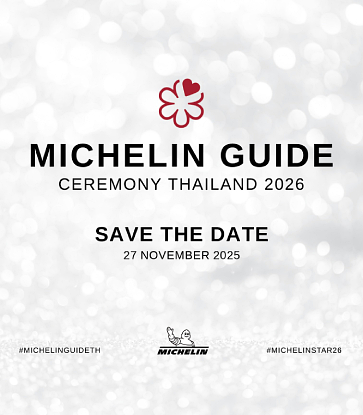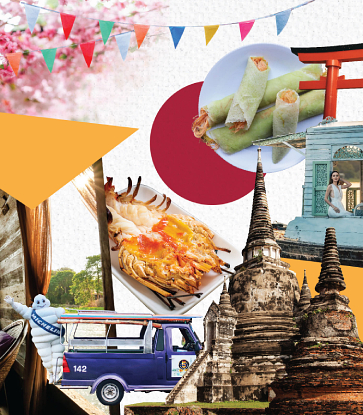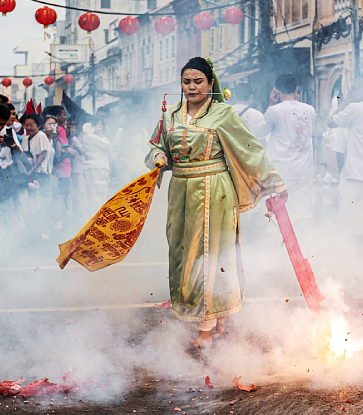It sometimes may seem that we take it for granted that Bangkok is one of the world's great dining cities. A brief internet search will reveal countless restaurants, ranging from humble street vendors to ultra-luxury chef's tables, as well as an attendant army of food bloggers, magazines, and marketing specialists directing the interested consumer to the table.
However, it has not always been this way, and it can be easy to forget that this is a relatively recent development. While Bangkok's street food scene has been globally renowned for decades (and rightly so), the sort of dining experience that has become encoded as international – which is to say, progressive-minded but rooted in European tradition, with all the caveats about cultural imperialism that labelling entails – is rather new, at least outside the walls of the city's five-star hotels. What started with a handful of pioneering French and Italian restaurants in the 1980s moving beyond the hotel gates and into the streets grew hand-in-hand with the boom years of the Thai economy. Thailand had fully emerged as a top-tier tourist destination, the country's diners had expanded by an order of magnitude, and Bangkok was ready for something new.
So how did this change happen? And how has the dining scene transformed over the past quarter-century?
To start, let us set the clock back to Spring 1998. The Good Friday Accords were being signed, functionally putting an end to decades of sectarian violence in Northern Ireland, and in Indonesia, decades of one-party rule were coming to an end. And on the radio, the charts were dominated by Celine Dion, K-Ci & JoJo, and Will Smith proceeding to get jiggy with it.

How it began
Here in Thailand though, things were not looking good. The irrational exuberance around Bangkok's construction boom finally came to a head, and the economy collapsed. But despite that, the city was looking to the future. And into these uncertain times, a young Australian named Darren Hausler stepped off a plane after a stint of teaching in Japan, and became part of a sea change in the country's dining scene by opening his now MICHELIN-listed restaurant Eat Me just off Convent Road in Bangkok's Silom neighbourhood. While many restaurants have risen and fallen in the 25 years since, Eat Me has not only survived, but it has remained relevant and evolved along with the city. It seems inevitable that Hausler would have something to say about how the industry has progressed.Hausler sets the scene: “Bangkok was already cool when I got here. The locals wanted to get out of the hotels and start exploring the new stand-alones.” And while it may sound quaint in this era of TikTok, magazine journalism played a major role too. “Back in the '90s, there were a few really cool magazines that thought Bangkok was a hidden gem... When some big magazines were coming in from so far away, they wanted to do more than just cover one restaurant, so they'd hit up everything in town, and we'd all benefit from the publicity this one place was getting.”
“We have not begun to see the impact that this next generation, the young guys that are in my kitchen right now, will have.”

While the world was getting to know Bangkok and its dining scene, challenges remained, especially when it came to sourcing quality ingredients that were not yet available at the local fresh market. Restaurants were dependent on just a handful of suppliers that had limited capacity and a fleet of unrefrigerated trucks (in Bangkok at the height of the hot season... draw your own conclusions). “The ingredients that are available in Bangkok now, there are just so many more... as the restaurants have flourished you find that there are a lot of suppliers that have come in at the same time looking to bring in new and exciting ingredients. We wouldn't have been able to do the food that we're doing now 25 years ago.”
Chef Tim Butler chimes in at this point. While he was not part of the original team, he has been with Eat Me for over a decade and has played a massive role in shaping what the restaurant has become. Raised in Maine and having made his bones under some of New York's most renowned chefs, he describes the situation with an East Coaster's straightforwardness.
“Heirloom tomatoes. Perfect example. Couldn't find a decent tomato that was, on purpose, green... That took us years, I was bringing in maybe like 50 kilograms of heirloom tomatoes from Spain once... Things you see all the time now, Iberico pork, f*** off! You couldn't find fresh Iberico pork. Wild king salmon, that was a nightmare for us to get for years. We were having to buy an entire box of wild king salmon; we're talking metric tons at 1,800 baht a kilogram... The liquor! Half the stuff we have in this restaurant right now, 10 years ago, impossible.”
The supply chain was also largely stacked against independent venues, as Chef Butler explains. “Most of these suppliers were designed and powered by the hotels, who were using good products, but they were all using the same products. So it must have been 2012, 2013, right around the time Bo.lan (the now-closed, one MICHELIN Star laureate) was opening... that we really began to have some influence on what the suppliers were bringing us.” Hausler agrees. “The food suppliers can see what's going on, they've upped their game.”
This is a clue too. Because as more and more restaurants open up, Hausler and Butler view them not so much as rivals as colleagues. As Hausler explains, “I think there's room for 1,000 times more restaurants in Bangkok, even though it's already a really good place to eat. The competition has really been beneficial as far as the market is concerned, the more restaurants there are, the more customers come into the city.”

The ever-changing scene of Bangkok
That being said, the competition also continues to change and evolve as both customer tastes and economic conditions change. Chef Butler notes that “in the last few years everything moved from big hotel dining, then everything started up, and strangely enough, it feels like it capped out a couple of years ago, and now post-COVID, there's been a crazy explosion of small, high-end tasting menu restaurants. That was a strange thing to see after COVID, the amount of cooks leaving restaurants, leaving this one, leaving that one, opening shoestring restaurants with MICHELIN Star agendas, realising they couldn't afford to do Le Normandie [the two MICHELIN star French restaurant at the Mandarin Oriental Hotel], but could afford to do omakase minimalist. You don't need much, just some wood, some paint, a couple induction burners, and three of your friends.” But as Hausler is quick to point out, “that's exactly how we started.”However, it is not just the restaurants that have evolved, it is the chefs themselves. Asked about how the old guard viewed the younger guys starting up their own venues, Butler says quite simply, “well... they've all worked at all our restaurants. They have access to all this stuff my older cooks didn't. They've worked at Thai restaurants, they've worked at Japanese restaurants, they've worked here, they've worked at Sühring. I think they've gotten a much larger cross-cultural expression. The generation that's coming up is 100 times more rounded than the previous generation that grew up working on the buffet.”
“I think there's room for 1,000 times more restaurants in Bangkok”

And for that matter he's quite optimistic about how the food scene will continue to evolve. “The younger Thai generation is much more well-travelled, they don't mind travelling on a budget... there's a greater appreciation of things foreign, and things local. Both have drastically evolved. We have not begun to see the impact that this next generation, the young guys that are in my kitchen right now, will have.”
As both Butler and Hausler reminisce about the earlier days in Bangkok, they point out how unrecognisable their long-time digs on Convent Road have become. And yet some things stay the same, such as, perhaps most importantly, their customers. “They are still coming from 25 years ago, but their kids are also adults, and some of those adults are friends with Chef Butler, but their parents used to come here when they were kids,” Hausler points out. The chef agrees, “Someone comes in, tells me the first time they came here, they were four. Now, they're 30, and they have their four-year-olds with them.”

The menu continues to shift and evolve, with Butler planning a brand-new slate of dishes. For first-timers he still recommends a dish of his that seems cryptic, “Clam”, but seems to reflect Eat Me’s whole ethos. It is a bowl of clams served with nam, a funky fermented Thai sausage more commonly stir-fried or made into rustic salads. In other words, something familiar but original. To wash it down, he suggests anything from the “Sip Some Thai” cocktail menu that, as he claims, “Pop the bartender was creating before anyone was playing with Thai cocktails.” Each is a take on a classic Thai dish, ranging from the more obvious mango sticky rice or miang kham to cocktails based on dishes like kaeng tai pla and som tam pu pla ra that dare to incorporate fish sauce.
What these anecdotes tell us is that even as the city evolves and changes, perhaps there is a unifying constant. Shophouses may be replaced by skyscrapers, songthaew may give way to metro lines, and new tastes and ingredients may take centre stage in Bangkok’s kitchens, but there will always be a sharing of abstract ideas and concepts along with a lovingly prepared dinner.
Illustration image: © Anuwat Senivansa Na Ayudhya/ MICHELIN Guide Thailand














%20-%20Aman%20Nai%20Lert.jpg)
.jpg)



